From hiking in nature preserves surrounded by plants and wildlife you won’t see anywhere else in the States to dipping your toes in the sand to strolling on manicured gardens, Southwest Florida is a paradise for outdoor adventures.
You’ll see a lot of wetlands -swamps, marshes, wet prairies, bogs, ponds, and the likes-, which means you’ll see a lot of migrating and native birds (you’ll be happy, birders!), reptiles, and mammals that hang around to feed on the buffet.
Manatees, turtles, ospreys, hawks, bobcats, Florida black bears (yes, bears) and roseate spoonbills call this place home.
The preserves and state parks are a refuge for endangered species such as the Big Cypress fox squirrel, the wood stork, and the Florida panther.
Your best time to visit is from November to April. The wet season runs from May to October when prairies and swamps flood, having a lesser chance to see wildlife.
Avoid September as it’s the wettest month with around 10 inches of rain.
The essentials: hat, sunscreen, sunglasses, water, and insect-repellant.
Disclosure: This post contains some affiliate links. If you make a purchase through those links I will earn a commission at no additional cost to you (zero, nada). To check the full disclaimer, click here.
Here’s what to do in Southwest Florida if you love nature and the outdoors.

Table of Contents
Explore the Big Cypress National Preserve
Big Cypress National Preserve, home of the Seminole and Miccosukee indigenous people, is a wetland that spans 729,000 acres, a safe haven for wildlife.
A difference in elevation and water levels, measured in a few feet, creates five different habitats: mangrove estuaries, cypress swamps, wet prairies, pine forests, and hardwood hammocks.
The preserve was created in 1974 to protect the natural flow of freshwater (and therefore the life of all living things around) from the Big Cypress Swamp down to the Everglades area and the Gulf of Mexico, and to prevent urban development from encroaching in this precious ecosystem.
The preserve is on a bird migration route (the Atlantic Flyway) making it a great place for birdwatching, with around 185 species recorded to date.
It’s also a great place to see orchids (you can find more than 40 types) and bromeliads, ferns, and weird-looking plants like the strangler fig.
The road traversing the preserve is Highway U.S. 41/Tamiami Trail, completed in 1928 and it was the first road connecting South Florida east to west. This is where you’ll find visitor centres, trailheads, and dirt roads’ access.
Before hitting the trails and side roads we went to the Big Cypress Oasis Visitor Center to learn about trail conditions, recommendations, and general information about the area and the wildlife. The center has bathrooms, a small store with snacks and drinks, waterproof pocket guides, and a big observation deck where we took a good look at a giant alligator sunbathing in the canal below.

You’ll also find a picnic area and two trailheads, including one for the famous 1,500-mile Florida Trail, which takes you north across the state.
Our first incursion inside the preserve was at the nearby Kirby Storter Roadside Park, on a boardwalk that takes you through a cypress swamp environment.

You’ll see the glory of the strong cypress trees reflected on the still-looking, dark water. This, next to the oak scrubs, are my favourite Floridian ecosystems.
Water lilies, ferns, and other trees covered in vines complete the enigmatic landscape.


The trail ends in an open platform overlooking the swamp forest.
We then drove to Loop Road (the entrance is marked by the Monroe Station), a dirt road that may require a 4×4 SUV during the rainy season.
A few minutes away from the station you’ll find the Gator Hook trailhead, the access point to a 5-mile round trip trail that takes you through a strand that was formerly a logging tram.
As we walked, the trail only got muddier and the water level higher, to the point where we were going to need a stick, high boots or waders, and a change of clothing (we had none).

If you want to explore this trail, come prepared to be under water up to your knees (or higher during the wet season), and remember there are alligators everywhere.
So we turned around and we kept driving a few miles down Loop Road. I didn’t find it to be much of a scenic drive (at least the section we did). It’s a rather narrow road with a wall of thick and tall vegetation on both sides that doesn’t let you see much through. We only found a handful of clearings with gator holes, where we spotted two alligators.

If you’re looking for a more scenic drive, with plenty of opportunities to see birds, head to our next stop.
Go back on the main highway and drive west to the H.P. Williams Roadside Park, with a picnic area and a long viewing platform where we spotted anhingas, little blue herons, egrets, and several alligators floating placidly in the water.

In search of more birds, we drove north along the Turner River Road (839), finding great blue herons on the trees.
Staying on 839 would have taken us to I-75 (Alligator Alley), but instead, we turned left on Upper Wagonwheel Road (837) to find more birds on the canal, including more anhingas, and adult and molting juvenile white ibis.

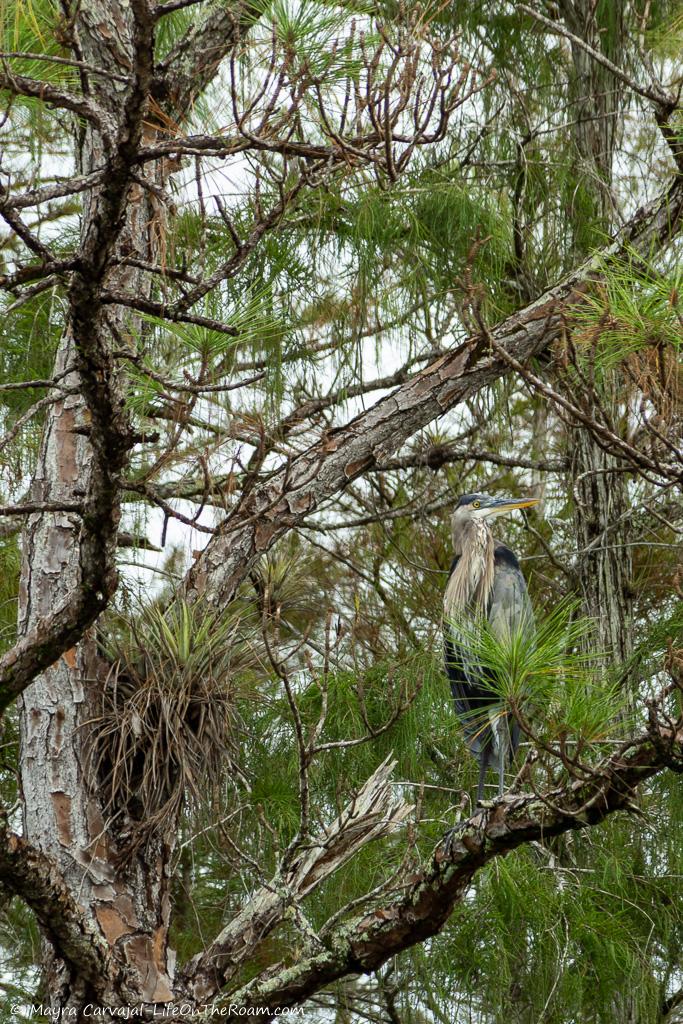
We turned left again and drove south on Bridon Road (841) to complete the 17-mile loop, and spotted a red-shouldered hawk eating its catch high on a tree.

Birdwatching paradise!
The Big Cypress Swamp Welcome Center (Nathaniel P. Reed Visitor Center) was our final stop in the preserve.
You’ll find a comprehensive exhibit, including a documentary, where you’ll learn about the preserve: its history, habitats, inhabitants, and resources to plan your visit.
There’s a store with nature books, guides, photographs, prints, snacks, souvenirs, and some apparel such as bug jackets to make your excursions more bearable, and a Ranger on-site to provide additional information.
Walk to the back of the building to check out one of the habitats in the preserve: a mangrove ecosystem that provides a safe haven for young aquatic life. Keep your eyes peeled for manatees.
You can explore the reserve on a bicycle, canoe, or kayak, or take an ATV tour to access the designated trails and experience the preserve in a different way.
There are also campgrounds to stay overnight if you’re into camping.
Big Cypress National Preserve
Oasis Visitor Center: 52105 Tamiami Trail East, Ochopee FL; 1.239.695.4111; Nathaniel P. Reed Visitor Center: 33000 Tamiami Trail East, Ochopee FL; 1.239.695.4758
Looking for car rentals in Florida? Check Rental Cars to compare rates and save.
Visit the Fakahatchee Strand Preserve State Park

The Fakahatchee Strand Preserve is the largest subtropical strand swamp in the world, with straight channels filled with water and trees, surrounded by prairies.
The preserve was established in 1974, west of the Big Cypress National Preserve, to protect the flow of fresh water to the estuaries in South Florida and protect life in the region.
Like its neighbour, it’s a refuge for endangered species and a fantastic place to see orchids -including the rare ghost orchid-, and the native royal palm in the wild.
Across its 85,000 acres, accessible through State Road FL-29, off the Highway U.S. 41/Tamiami Trail, you may also see bobcats, white-tailed deer, Florida black bears, birds of prey, and river otters.
You can explore Florida’s largest state park by taking Jane’s Scenic Drive and hiking or biking the trails, taking Ranger-guided walks or tram tours, or (what we did) taking a walk along the Big Cypress Bend Boardwalk, right off the Tamiami Trail.

And what a beautiful and informative walk it is.
Along the 1.2 Kms. you’ll find signs teaching you about the plants and animals calling this place home.
I kept looking down at the weird cypress knees -scientists think they help with stability in the very unstable swamp floor-, searching for wildlife in the murky waters, and looking up at the majestic trees covered in epiphytes. So tall, it was hard to see the top.
I didn’t see any orchids around (not the season), but I did find some pretty swamp lilies.

An alien-like plant stopped me in my tracks. I wondered right away if H.R. Giger, the man behind Alien movie creatures, had been around here. From the picture below, what do you think?

This is a strangler fig. It starts as an innocent seed landing on the top of a tree, and then it sprouts, grows massive roots, and turns into this monster-looking plant that strangles its host.
Just like when the alien jumps from the egg straight into the face of its victim. Yikes!
The boardwalk ends on a viewing platform from where we saw a big alligator floating in the swamp, surrounded by fireflags.

This is a fantastic opportunity to taste a small sample of the strand if you’re short of time or if you can’t do the hiking trails.
Fakahatchee Strand Preserve State Park
137 Coastline Dr., Copeland FL; 1.239.695.4593; Open: 8AM to sunset; General admission: $3 per vehicle; $2 for pedestrians and bicyclists; Suggested Donation (boardwalk): $3.00 per adult
Visit the Collier-Seminole State Park
You may find royal palms lining up the entrance of fancy resorts and upscale private residences, but finding them in the wild is another story.
This 7,271-acre park preserves one of the original royal palm hammocks, sharing its domain with a mangrove swamp.
Don’t come looking around for tall royal palms, though. Lightning has killed them all, but new ones are growing.
We did one of four trails: the Royal Palm Hammock Trail, a 0.9-mile loop bordering a salt marsh where you’ll see tropical plants that are unique to the hammocks of Southern Florida.

On the first part of the trail, you’ll walk on a semi- rocky path among tropical plants and trees before entering a low boardwalk with live oaks covered by resurrection ferns leading to a section with sabal palms (Florida’s state tree).

To access the other three trails you have to go back on the highway as they’re located in a different area.
You can also explore the mangrove habitat by paddling along the Blackwater River. Rent a kayak and canoe on-site and launch it from the dock located close to the Royal Palm Hammock trailhead.
Before reaching the docks you’ll drive through a section of the park with some signs, monuments, and artifacts dedicated to the history of the park and the region, from the time when the Caloosa tribe inhabited these lands and the Seminole and Miccosukee carved out cypress trees to make canoes.
It was interesting to see the historic “walking dredge”, a massive 33-feet piece of equipment, the last of its kind, used to build a portion of the Tamiami Trail in the 1920s.

You can read about the excavation, the portable bunk houses that followed the crew, providing food and shelter, and the challenging work conditions -the swamp, the mosquitos, the sun, the heat- with low pay that didn’t match the effort.
You can also rent bicycles on-site if you want to explore the Prairie Hammock Trail on two wheels.
Collier-Seminole State Park
20200 Tamiami Trail East, Naples FL; 1.239.394.3397; Open all year-round: 8AM till sunset; General admission: $5 per vehicle; $2 pedestrians and bicycles. Additional fees for camping and other activities; Pets allowed (must be leashed at all times)
Search for Wildlife at the Ten Thousand Islands National Wildlife Refuge Marsh Trail
The Ten Thousand Islands National Wildlife Refuge was established by the U.S. Fish and Wildlife Service in 1996 to protect the ecosystem in the estuary and provide refuge to about 189 bird species, 200 fish species, manatees feeding in the seagrasses, and sea turtles.
It spans across 35,000 acres of freshwater marshes, saltwater marshes, ponds, hammocks of palms and tropical hardwoods, and seagrasses.
The Marsh trail is a 2.2 miles (3.5 kms) round trip through a brackish marsh (where freshwater and saltwater meet) that turns into a saltwater marsh in the southern part of the refuge.
The trail is paved up to the accessible observation tower from where you’ll have a fantastic view of the marsh, the mangrove islands, and the birds.

We saw moorhens, great blue herons, anhingas, vultures, and ducks.

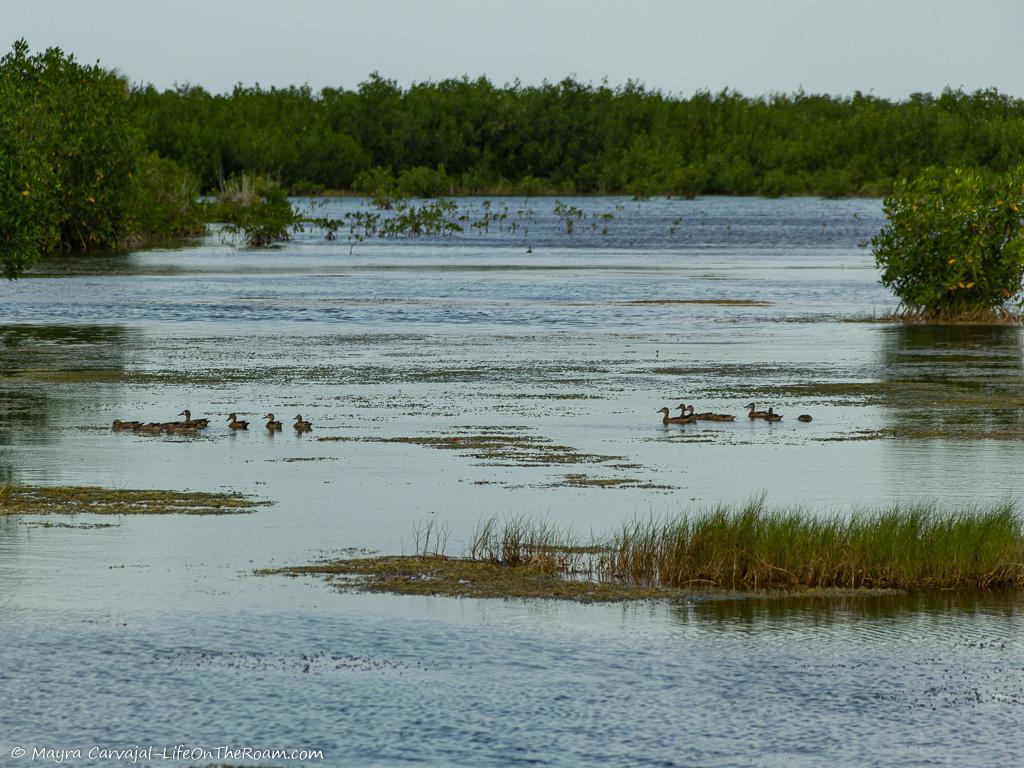
It switches later into a dirt road flanked by trees where I saw these cute migrating songbirds, a yellow warbler, and a great crested flycatcher, who stick around this region during the shoulder seasons.

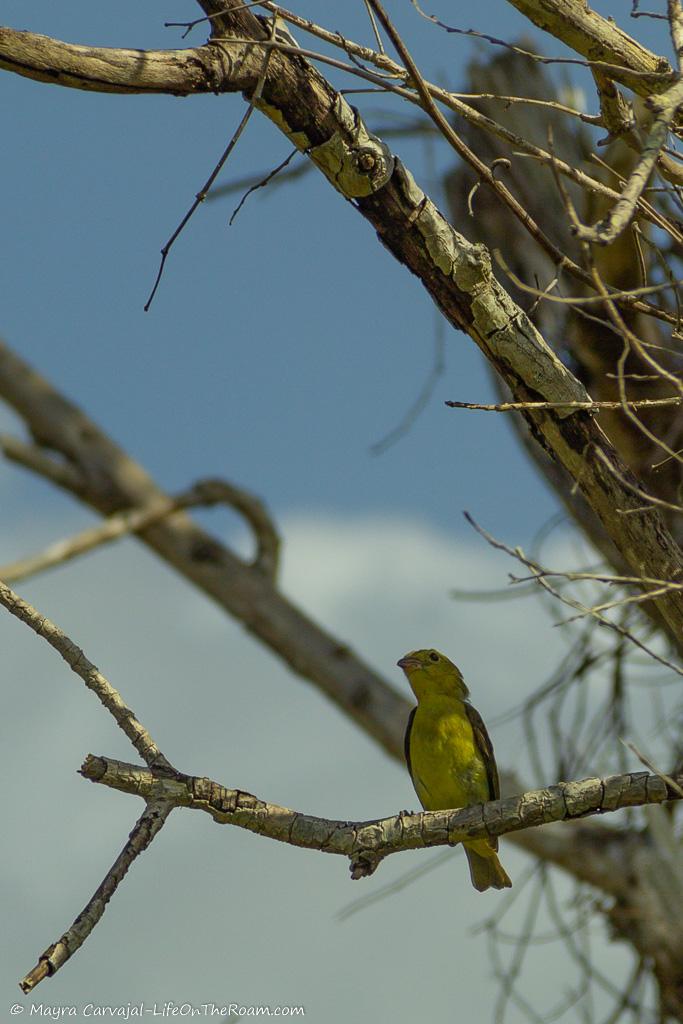
Multiple openings in the vegetation will let you take a peek into the mangroves and the aquatic wildlife.
The trail ends in an open area bordered by a canal where you can see more birds hanging out in the trees.
You can also explore the refuge on a kayak, floating on any of the four canoe trails.
Come prepared with sunscreen and a hat as there’s little shade along the trail, and sunglasses will help to keep away pesky eye gnats.
Ten Thousand Islands National Wildlife Refuge
21004 Tamiami Trail East, Naples, FL; Donations welcomed; Pets allowed (must be leashed at all times). There are no facilities on site.
Have a Beach Day at Marco Island (or Paddle Around the Reserves)
Sandy, flat, clean, and shallow, Marco Island’s beaches are perfect for relaxing after a day of hiking and paddling as it’s located within Ten Thousand Islands, close to the wildlife refuges and nature preserves.

It’s a convenient stop to lay on the sand, have a picnic, check out colourful shells, or enjoy some cocktails at any of the restaurants. It’s one of the best West Coast Florida attractions for planning a beach day.
You can also make it your home base during your visit to Southwest Florida and stay at one of the many Marco Island hotels or condos.
Even though the streets along the ocean are walled up with vacation properties and some beaches are private, there’s access to three public beaches.
There’s Tigertail Beach on the north side, with kayak and paddleboard rentals, Marco Beach (Public Beach) in the middle section of the island, and South Public Beach close to Swallow Avenue.
Be aware that the limited public parking may be as far as a 10-minute walk and you’ll need a credit card.
For a more active experience exploring the mangroves of Marco Island and its wildlife, check out these popular tours:
Kayak Tour Marco Island: kayak or paddleboard through the mangrove forest for a chance to see dolphins and manatees up close. Duration: 2 hours.
Book this tour, with a rating of 5/5 based on more than 970 reviews.
Marco Island Dolphin Sightseeing Tour: this boat tour takes you around the waters of the Ten Thousand Islands to spot dolphins and shorebirds.
See wildlife with this tour, with a rating of 5/5 based on more than 460 reviews.
Enjoy Art and Nature at the Naples Botanical Garden
This is a unique garden in the sense that it has a specific theme: creating art-inspired displays using plants from regions around the world, located between the 26th latitude north and 26th latitude south.
The tropical and sub-tropical climate that is prevalent within this specific boundary -which includes Naples- makes it possible to enjoy a colourful and bountiful landscape all year round.
At $25 per person, the admission price may seem steep when you compare it to other gardens’ fees.
But, is it worth it? Absolutely.
Not only is it one of the most beautiful and artsy gardens I’ve visited, but it also offers several guided tours throughout the day (starting mid-morning) covering different subjects, and temporary special exhibits. All included with admission.
You’ll also find friendly and knowledgeable staff available to answer any questions regarding the garden. It’s one of the best outdoor things to do in Naples.
Across its 170 acres featuring ponds, fountains, murals, informative signs, trees, and manicured gardens, you’ll be transported to four different regions.
From the entrance, you’ll have a great panoramic view of the Brazilian Garden, one of my favourite spots.
In the background, you’ll see a colourful mural designed by Burle Marx, a world-renowned Brazilian landscape architect and artist.

The garden, named after him and designed by his apprentice, Raymond Jungles, overlooks an infinity pool cascading into a small pond.
The water is dotted with lilies and the giant pads of the Amazon water lilies resembling big round serving trays. You can see more aquatic flowers that will give you a Monet-esque vibe in the nearby Water Garden.


Don’t miss the multicoloured Jurema Tree (also called muscle tree), next to the water feature. It’s native to Brazil and quite a sight to behold and protect, as it’s an endangered tree.
An extensive area of the garden is devoted to the Floridian landscape.
After crossing a boardwalk above a freshwater swamp I walked among South Florida slash pines on the lookout for the resident gopher tortoises in the Florida Uplands Preserve.
I ended up on the paved trail that takes you around Lake Tupke, watching birds perched on the trees.


In the South Wetlands Preserve, I spotted some of Florida’s wildlife. There’s plenty of fish seeking refuge in the red mangrove roots, birds foraging in the brackish marsh, and waterfowl floating around.
You can enjoy a panoramic view of the marsh and the lakes from the White Birding Tower.

I found another elevated view of the lakes from the Florida Garden, with a foreground in the form of a cascading fountain with flowers.
The Asian Garden is a beautiful oasis where architectural and landscaping elements like mosaic murals, temples, pavilions, lotus ponds, and sculptures work in perfect harmony to transport you to Indonesia and Thailand.


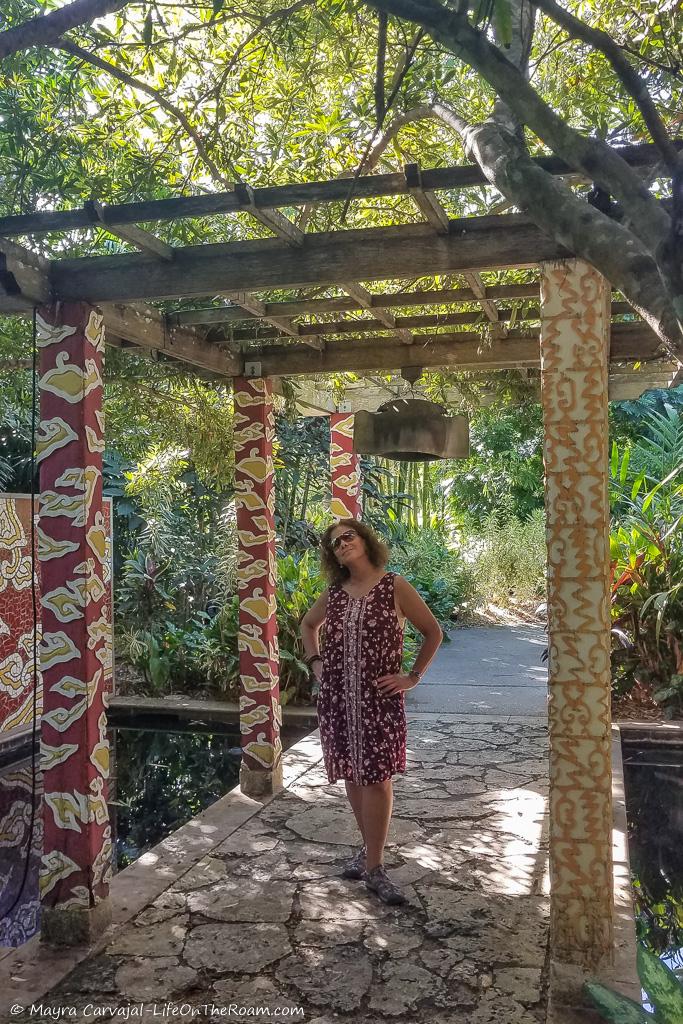
Another winner in my books was the LaGrippe Orchid Garden.
Stroll in the garden and along the boardwalk with the gentle sound of water features in the background as you marvel at the colour and variety of orchids. Pentagon-shaped, star-shaped, monochrome, multicoloured, striped, speckled, tiny, you name it.
As an added bonus, close to the entrance, you’ll see a big specimen of the tiger orchid. The whole plant was so big I thought it was a small tree until I saw the abundant flowers and read the label.
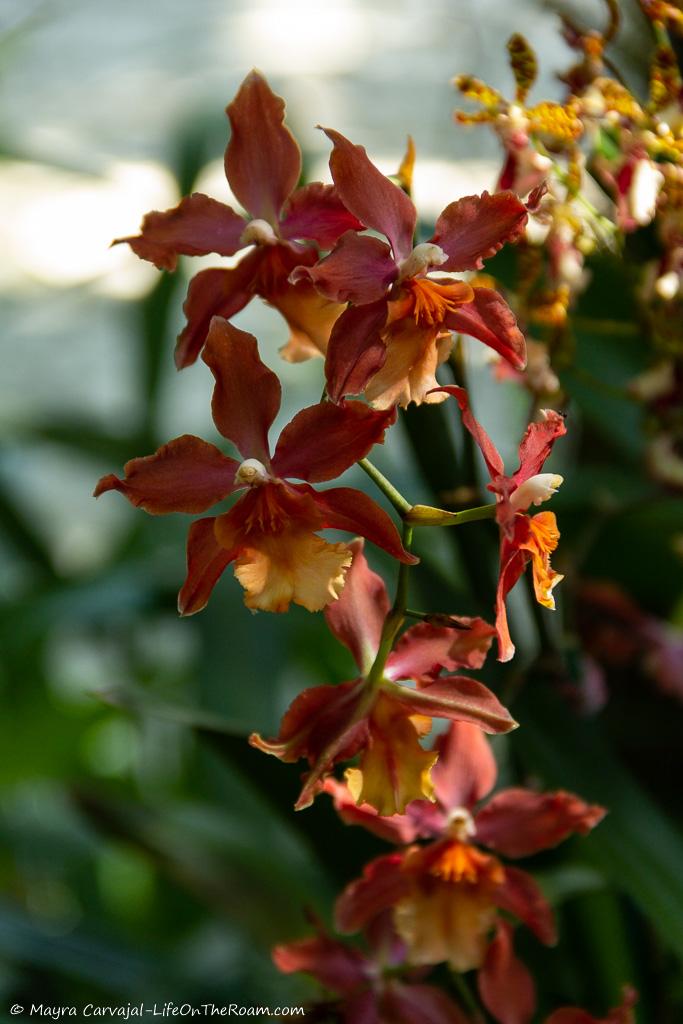


The tiger orchid holds the Guinness World Record for having the world’s tallest orchid specimen, reaching up to 25’. Oh, how I would love to see the thousands of flowers coming out of that massive stem.
Another region you can find out more about is the Caribbean. Its diverse landscape is much more than sun, sea, and sand. Don’t miss the immersive Stickwork Sculpture by Patrick Dougherty woven on site.
You can also visit the temporary exhibits, attend special events, and learn more about the sustainable design of the garden and the visitor centre.
The garden has a cafe on-site and a store selling really cool stuff.
Naples Botanical Garden
4820 Bayshore Dr. Naples, FL; 1.239.643.7275; Open daily: 9AM-5PM; General admission: $27
CREATE ART WITH THE BEAUTY OF NATURE
Let your inner artist take over and bring to life these hand-drawn colouring pages for adults, featuring imaginary gardens.
Express your creativity and relax by applying your own palette to 50 original illustrations.
Print them at home, download them to your colouring app, or buy them as a gift to your art and nature loving friends.
See a preview and get yours today
Walking or paddling through unique habitats you won’t see anywhere else, with so much wildlife to end up with a drained camera battery, is an experience not to miss when visiting Southwest Florida.
YOU MAY ALSO WANT TO READ
BOOKING FLIGHTS AND ACCOMMODATIONS
Book your flight without losing your shirt
We check Momondo to find great deals to book our flights. Also, check Great Escape: it combines the listings from Expedia, Kiwi, Kayak, (and Skyscanner on the premium service) to find the best airfares.
To find a place to stay for less
Booking.com: you’ll find any type of property you can think of in their massive listing, with one of the most comprehensive filters. We’ve found great deals on boutique hotels, apartments, and private rooms in hostels.
Hotwire: the first site I check when we plan to stay at a hotel for a few nights. You can save anything from 20% to 60%. Use the search filter to find what you want and you’ll end up with three listings that match your criteria. You’ll know which one you’ll get after you book. If you can handle a little bit of uncertainty you can score big savings.
House Sitting: you take care of people’s pets and house for free while staying for free. It’s the closest thing to experiencing a place “like a local”. But it comes with responsibilities… Are you an animal lover? It may become your new way to travel.
To get travel insurance
SafetyWing: travel medical insurance that gives us peace of mind knowing that we’re covered in case of emergency. It’s convenient, affordable, and suitable for digital nomads who spend a long time outside their home country.
Check the full list of travel resources on my Resource Page for more options and savings


Asian Garden looks so peaceful and beautiful! Your photos are stunning 🙂
Thank you! Yes, there are plenty of ponds and water features in the Asian Garden.
Fantastic detail, makes me wish I could start planning a trip soon.
Love the photos.
Thanks! Florida has enough activities to fill your itinerary.
Woooow, your photos are so stunning, especially that one with the big alligator! ♥ Do you have really made every shot by yourself? I am really amazed by this post and Southwest Florida too!
Yes, I take all the pictures. Having many platforms overlooking the swamps (one of the great things in Florida) helps to get close to the alligators in a safe way. And of course a zoom lens! 😀
This is a nice place to create memories. The serene and peaceful environment is perfect for a great gateway!
Yes! Just sitting to hear and watch the birds is super calming.
Time spent amongst trees is never wasted time
Wise and true words.